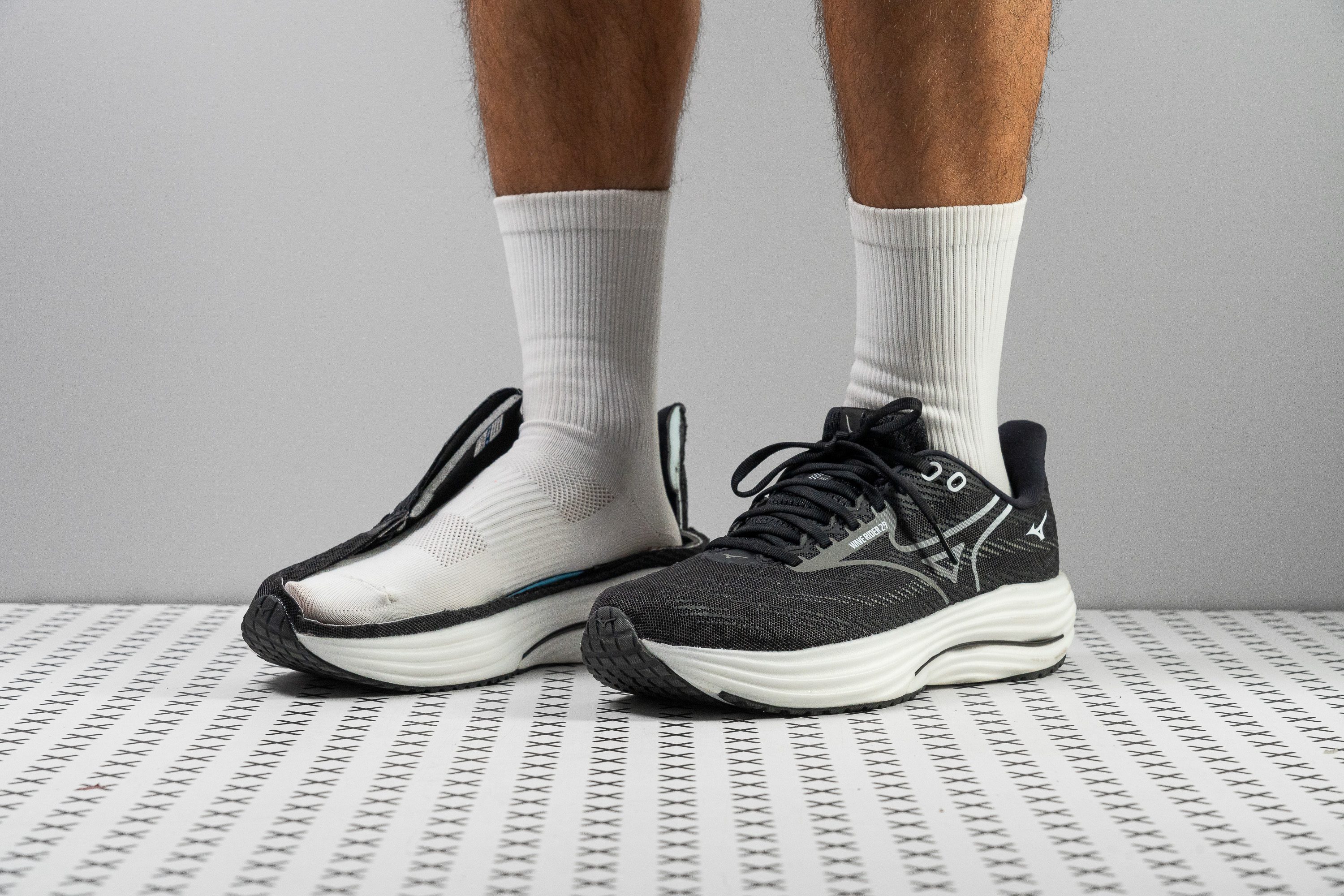Our verdict
- Top pick in best Mizuno running shoes
Pros
- Softer Enerzy NXT midsole
- Improved shock absorption
- Works well for wide feet
- Finally lower drop!
- Classic feel with minimal rocker
- Lighter than predecessor
- Solid overall durability
- Excellent fit and heel lockdown
- Impressive stability
Cons
- Price increase
- Ride is not very exciting
- New drop can disappoint longtime fans
- A bit stiff
Audience verdict
Comparison
The most similar running shoes compared
+ + Add a shoe | |||||
|---|---|---|---|---|---|
| Audience score | 86 Good! | 89 Great! | 84 Good! | 91 Superb! | |
| Price | £140 | £160 | £160 | £165 | |
| Pace | Daily running | Daily running | Daily running | Daily running | |
| Shock absorption | High | High | High | High | |
| Energy return | Low | Moderate | Low | Moderate | |
| Traction | High | High | High | Moderate | |
| Arch support | Neutral | Neutral | Neutral | Neutral | |
| Weight lab Weight brand | 9.1 oz / 258g 9.3 oz / 265g | 9.9 oz / 282g 10 oz / 283g | 9.7 oz / 276g 9.7 oz / 275g | 9.6 oz / 271g 9.8 oz / 277g | |
| Drop lab Drop brand | 8.3 mm 10.0 mm | 8.7 mm 5.0 mm | 8.0 mm 5.0 mm | 10.0 mm 8.0 mm | |
| Strike pattern | HeelMid/forefoot | HeelMid/forefoot | HeelMid/forefoot | HeelMid/forefoot | |
| Size | - | True to size | True to size | True to size | |
| Midsole softness | Soft | Soft | Soft | Soft | |
| Difference in midsole softness in cold | Normal | Normal | Normal | Normal | |
| Toebox durability | Decent | Decent | Bad | Good | |
| Heel padding durability | Good | Good | Good | Good | |
| Outsole durability | Decent | Good | Good | Bad | |
| Breathability | Moderate | Breathable | Moderate | Moderate | |
| Width / fit | Medium | Medium | Medium | Medium | |
| Toebox width | Wide | Narrow | Medium | Medium | |
| Stiffness | Moderate | Stiff | Moderate | Moderate | |
| Torsional rigidity | Stiff | Stiff | Stiff | Moderate | |
| Heel counter stiffness | Stiff | Stiff | Moderate | Moderate | |
| Heel lab Heel brand | 37.5 mm 39.0 mm | 39.3 mm 39.0 mm | 38.7 mm 38.0 mm | 40.7 mm 42.0 mm | |
| Forefoot lab Forefoot brand | 29.2 mm 29.0 mm | 30.6 mm 34.0 mm | 30.7 mm 33.0 mm | 30.7 mm 34.0 mm | |
| Widths available | NormalWide | NormalWide | NormalWide | NormalWide | |
| Orthotic friendly | ✓ | ✓ | ✓ | ✓ | |
| Season | All seasons | SummerAll seasons | All seasons | All seasons | |
| Removable insole | ✓ | ✓ | ✓ | ✓ | |
| Ranking | #193 Bottom 48% | #113 Top 31% | #230 Bottom 38% | #25 Top 7% | |
| Popularity | #130 Top 35% | #117 Top 32% | #198 Bottom 46% | #207 Bottom 44% |
Who should buy
In our opinion, the Mizuno Wave Rider 29 fits perfectly for:
- Runners who prefer an old-school daily trainer without a pronounced rocker or ultra-plush midsoles. This is the dependable shoe that works for almost anyone.
- Midfoot and heel strikers who want a workhorse with a bit of added stability.
- Those who liked the Wave Rider series but were put off by its very high drop. Mizuno finally reduced the offset from heel to toe.
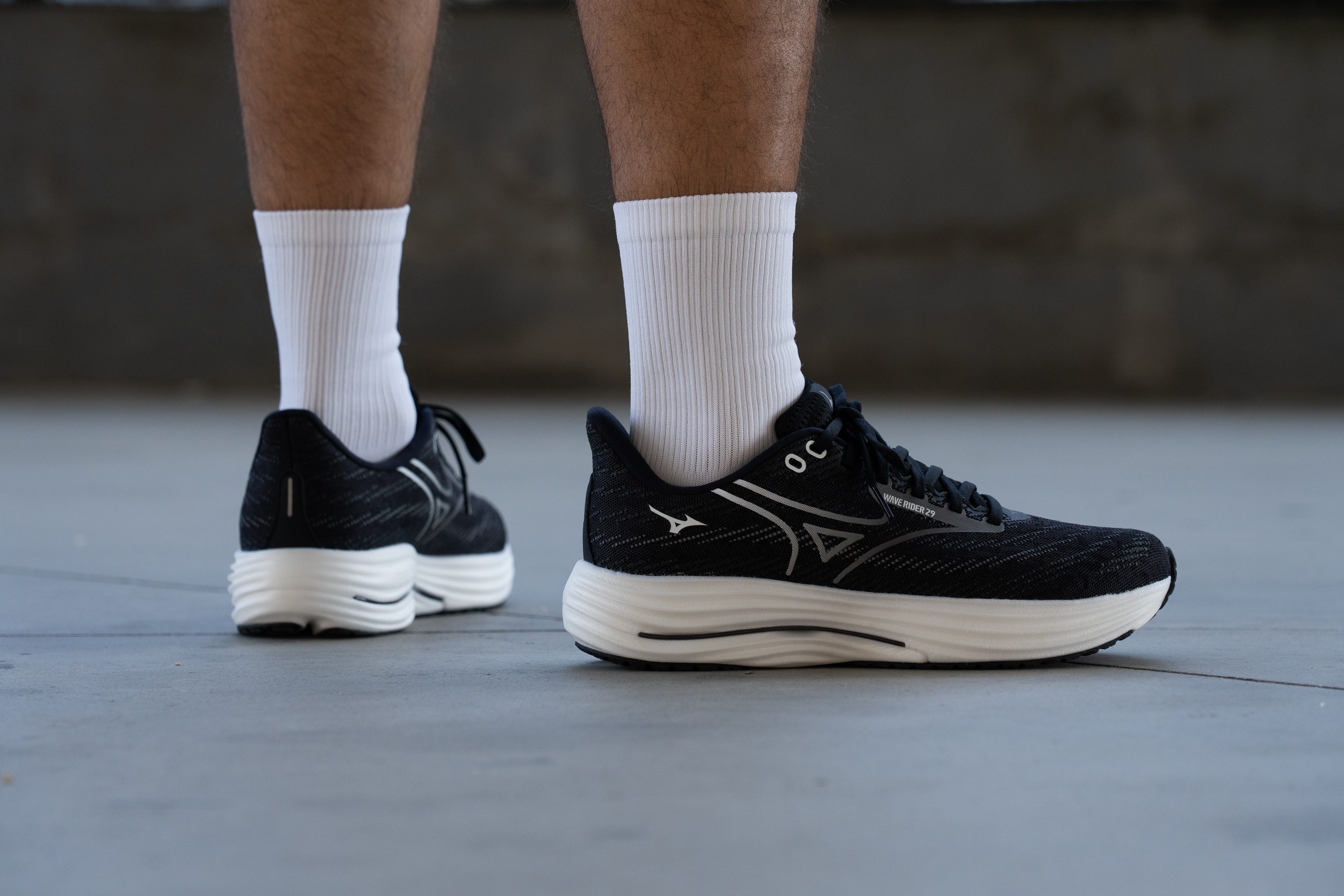
Who should NOT buy
From our perspective, we do not recommend the Wave Rider 29 if you want strong energy return. After testing, we discovered that its midsole still feels flat compared to faster daily trainers, and we believe that shoes like the Adidas Supernova Rise 2 or the HOKA Mach 6 offer a more lively, fast-paced ride at a similar price.
We also think it’s not the best option for runners who want a daily trainer that looks and feels modern. In fact, this shoe is quite the opposite, as it aims to stay simple and unnoticed. If you prefer a bolder design with a more modern feel underfoot, models like Mizuno Neo Zen or the ASICS Novablast 5 are better choices.
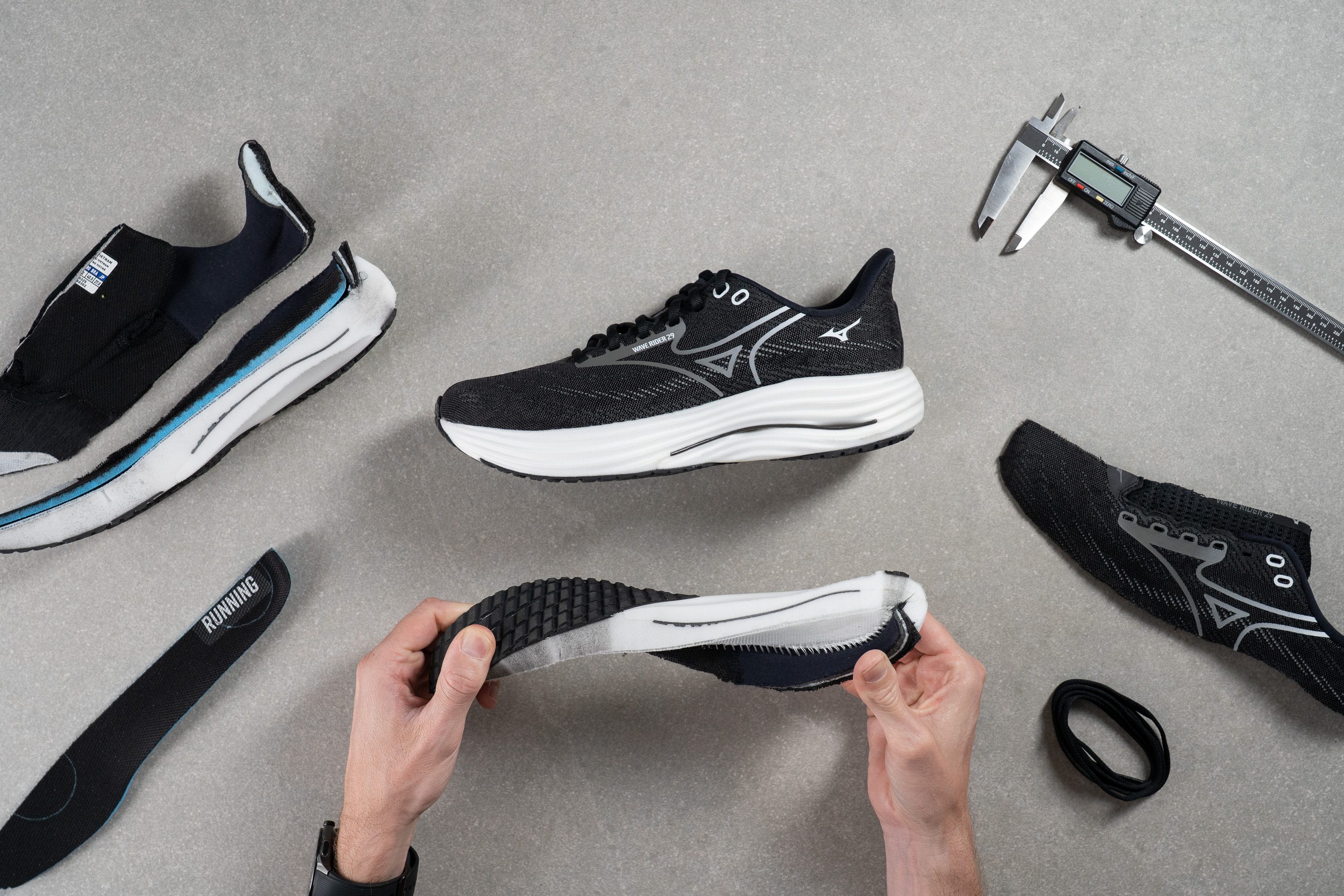
Cushioning
Shock absorption
The Wave Rider series has been a long-time partner for fans of the Japanese brand for long runs, and we tested that version 29 is the only one we can recommend as of today for that kind of workouts.
With 142 SA in the heel and 116 SA in the forefoot, we discovered that it fully qualifies as a well-cushioned shoe—especially in the forefoot where it only had 99 SA in the Wave Rider 28—creating now a more protective ride.

| Wave Rider 29 | 142 SA |
| Average | 129 SA |
Energy return
There’s a minor improvement on energy return from last year too, moving up to a still-modest 53.3% in the heel and 55.8% in the forefoot.
These numbers might’ve been okay five years ago, but we think that Mizuno can do a better job here, and energy return should be at least in the 60% ballpark to better compete with most modern rivals.
| Wave Rider 29 | 53.3% |
| Average | 58.5% |
Heel stack
The Wave Rider 29 comes with a real heel stack of 37.5 mm, so it’s still comfortably over the average and shows the potential of this shoe for heavier guys or anyone who wants to tackle long runs on it with a highly-supportive feel.

And while it's tempting, Mizuno may want to avoid increasing it a little bit to adjust to the competition and current market trends. They have other shoes for that...

| Wave Rider 29 | 37.5 mm |
| Average | 34.8 mm |
Forefoot stack
The forefoot offers a lot of foam underfoot too, and totals 29.2 mm of height in our calipers. Clearly, this shows how this shoe has benefitted from a small but meaningful tweak that we’re gonna comment right now.
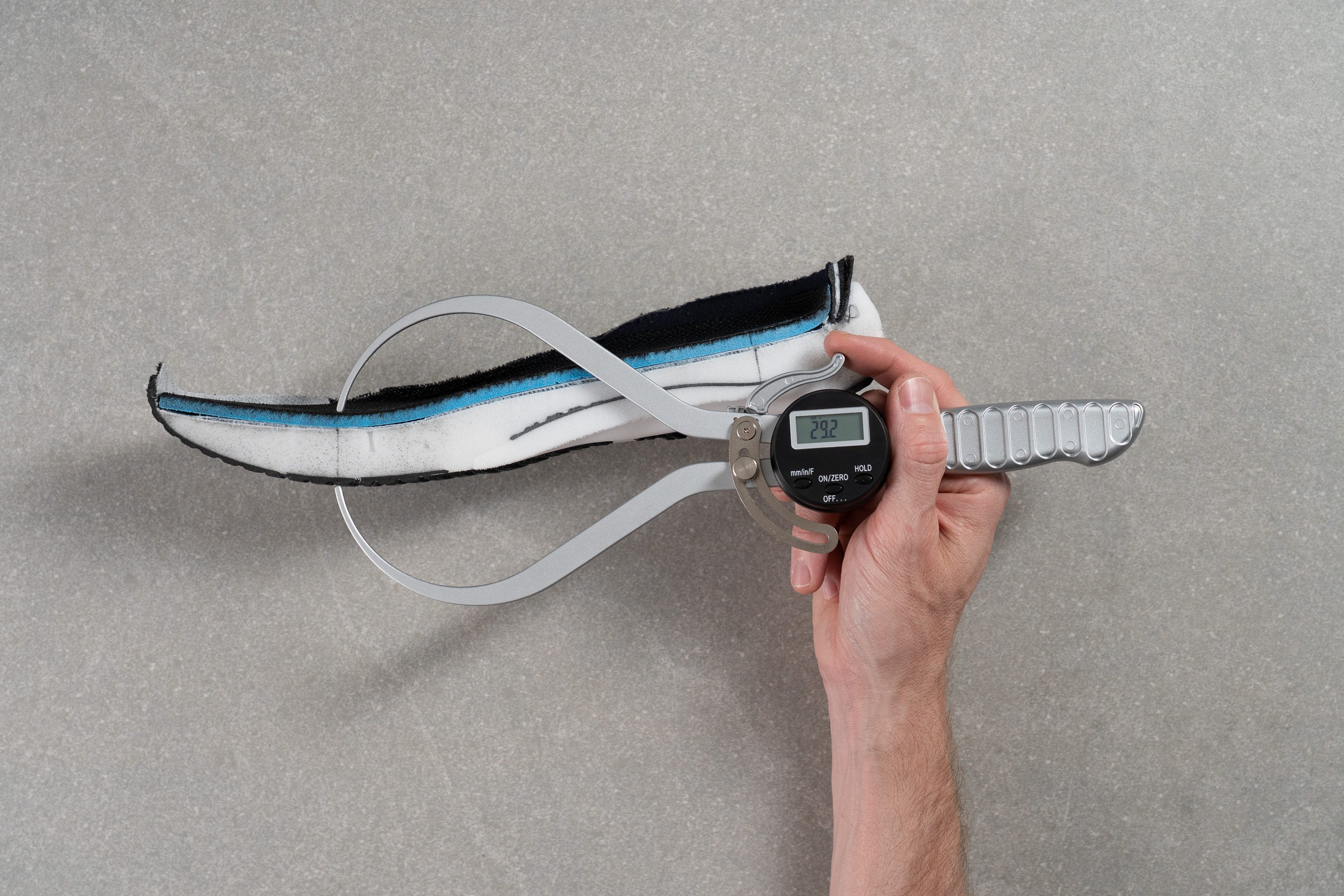
| Wave Rider 29 | 29.2 mm |
| Average | 26.2 mm |
Drop
And that change is the new drop. The Mizuno Wave Rider series was famous in the running shoe world for its massively steep 12 mm drop, but that finally changed to 10 mm.
In fact, we measured less than those official 10 mm at only 8.3 mm, which marks a huge depart from the classic feel of the Wave Rider but makes it way more universal and ready to handle midfoot and forefoot strikers much better than before.

| Wave Rider 29 | 8.3 mm |
| Average | 8.6 mm |
Midsole softness
The Wave Rider 29 not only feels more cushioned than before, but also much softer. This shoe finally moves to a full Enerzy NXT (nitrogen-infused EVA) midsole instead of sharing that compound with the old Enerzy.
The main layer of Enerzy NXT feels more plush than what we’ve ever felt in another Wave Rider until now, and our durometer reading of 16.9 HA further confirmed that we were on the right path.

| Wave Rider 29 | 16.9 HA |
| Average | 20.4 HA |
Secondary foam softness
The secondary layer of Enerzy NXT sits in the lower part of the midsole and it’s the one that first touches the ground, which helps create a more stable feel. For that reason, Mizuno made it a bit firmer to add extra stability, and we measured it at 19.9 HA, which is 15% firmer.

| Wave Rider 29 | 19.9 HA |
| Average | 22.7 HA |
Rocker
We’re glad to confirm that the Mizuno Wave Rider 29 is, one more year, a very solid option for runners who want a shoe with a classic feel and a flatter profile, avoiding all those ultra-rockered models that keep appearing everywhere. It might even feel a bit too classic!

Plate
The Pebax-based Wave Plate is one of the unique features of the Wave Rider series, and it still sits inside the midsole of version 29 from the heel to the midfoot, working quietly in the background for stability.
Size and fit
Size
Width / Fit
We created a gel mould of the fit and took detailed measurements to compare it directly with other shoes.
From that process, we recorded a width of 94.6 mm at the mould’s widest point, a result that places the Wave Rider 29 squarely within the average range for mainstream daily trainers.
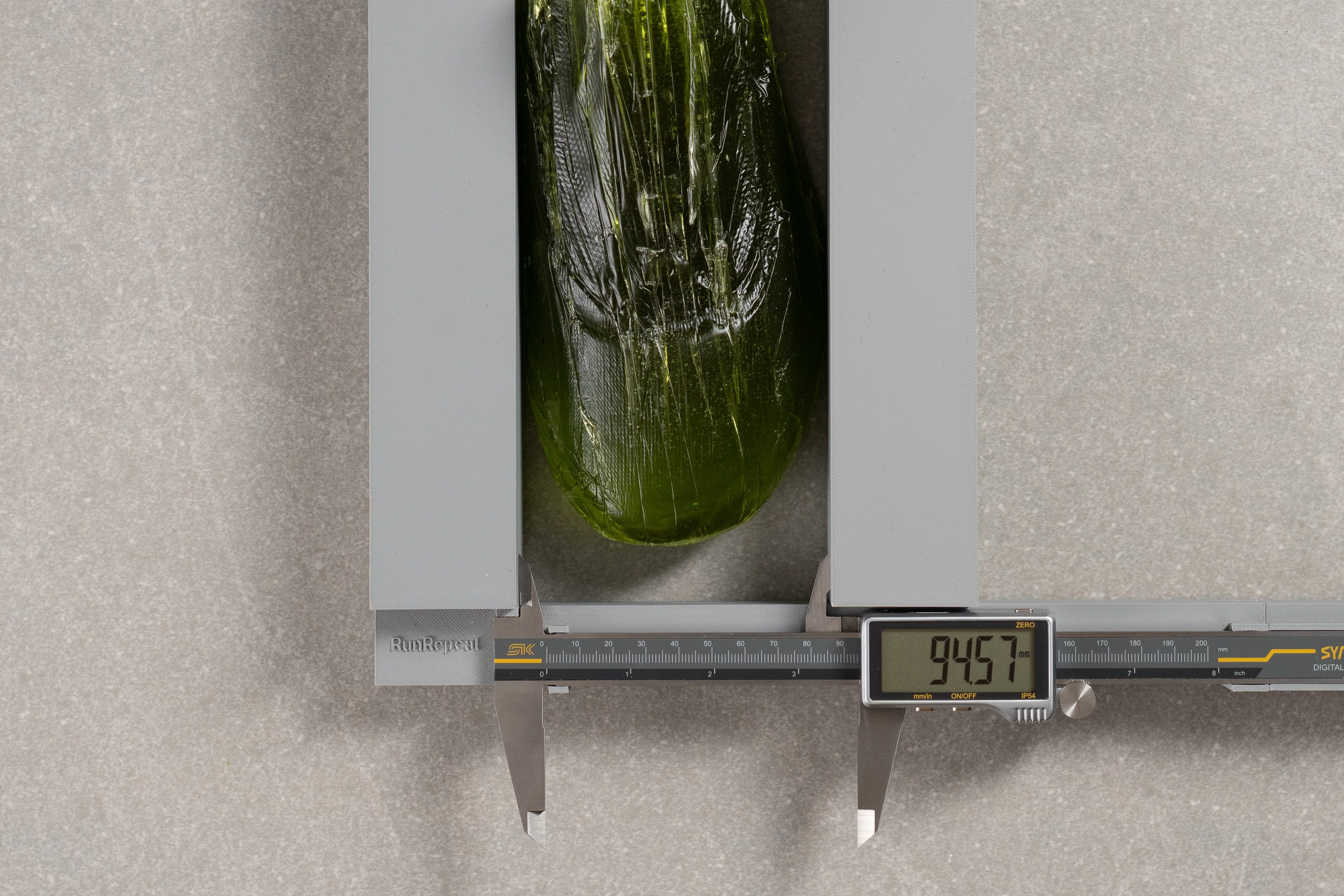
| Wave Rider 29 | 94.6 mm |
| Average | 95.1 mm |
Toebox width
While the first measurement was close to average, we verified that there is now more room for the toes with 76.7 mm in this second one, making the Wave Rider 29 more appealing for runners who need a few extra millimetres because of their foot shape.
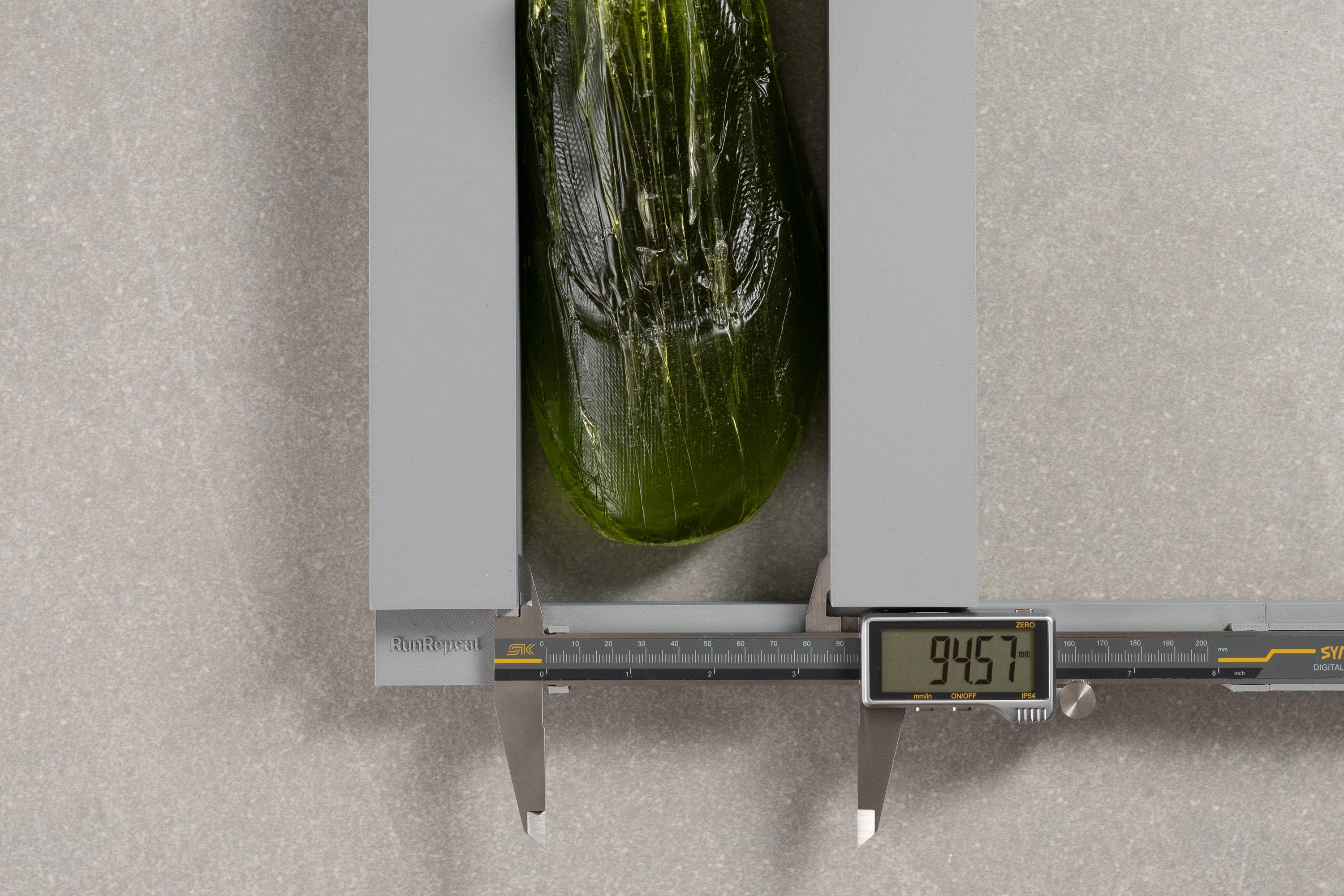
| Wave Rider 29 | 76.7 mm |
| Average | 73.3 mm |
Toebox height
We also found the toebox to be very generous, making the shoe a great match for runners with a high-volume foot.
When we measured our gel mould for height, we recorded 28.3 mm.
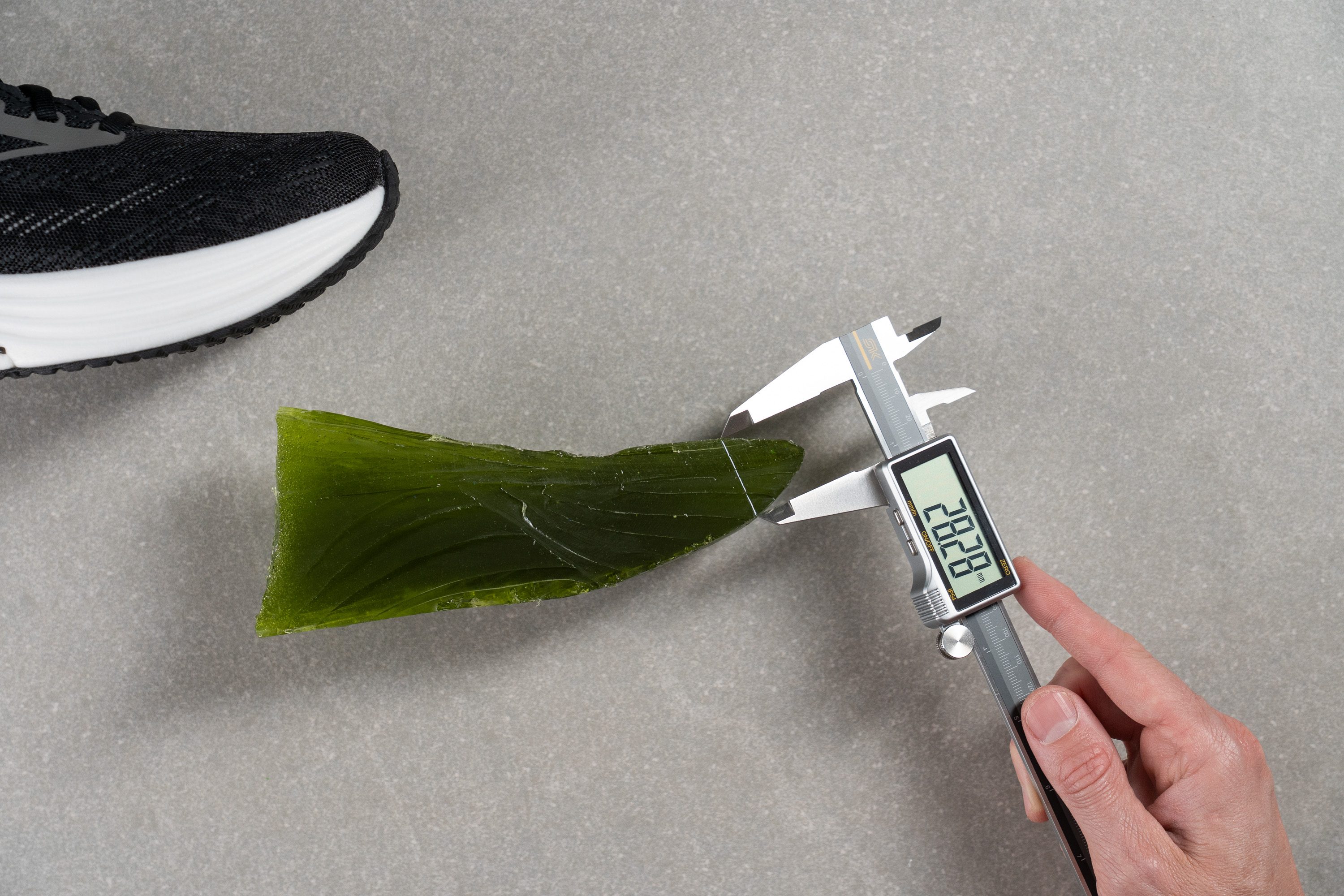
| Wave Rider 29 | 28.3 mm |
| Average | 27.1 mm |
Traction / Grip
Traction test
It seems to us that the Wave Rider 29 is all about getting minor but positive improvements, and the X10 rubber delivered more grip than version 28.
Last year we got 0.48 in this same test, and this new model comes with 0.52. Not a life-changing upgrade but who can complain when things get better? Not us.
| Wave Rider 29 | 0.52 |
| Average | 0.48 |
Outsole design
The outsole design stays very close to what we usually see in the Wave Rider series, with four large rubber sections, two in the rear and two in the front, laid out in a clean pattern.
Thanks to the shift to a full Enerzy NXT midsole, Mizuno no longer needed the huge cutout from version 28 that trapped small stones and sometimes felt awkward. That area is now fully filled with foam, which also adds a bit more shock absorption.
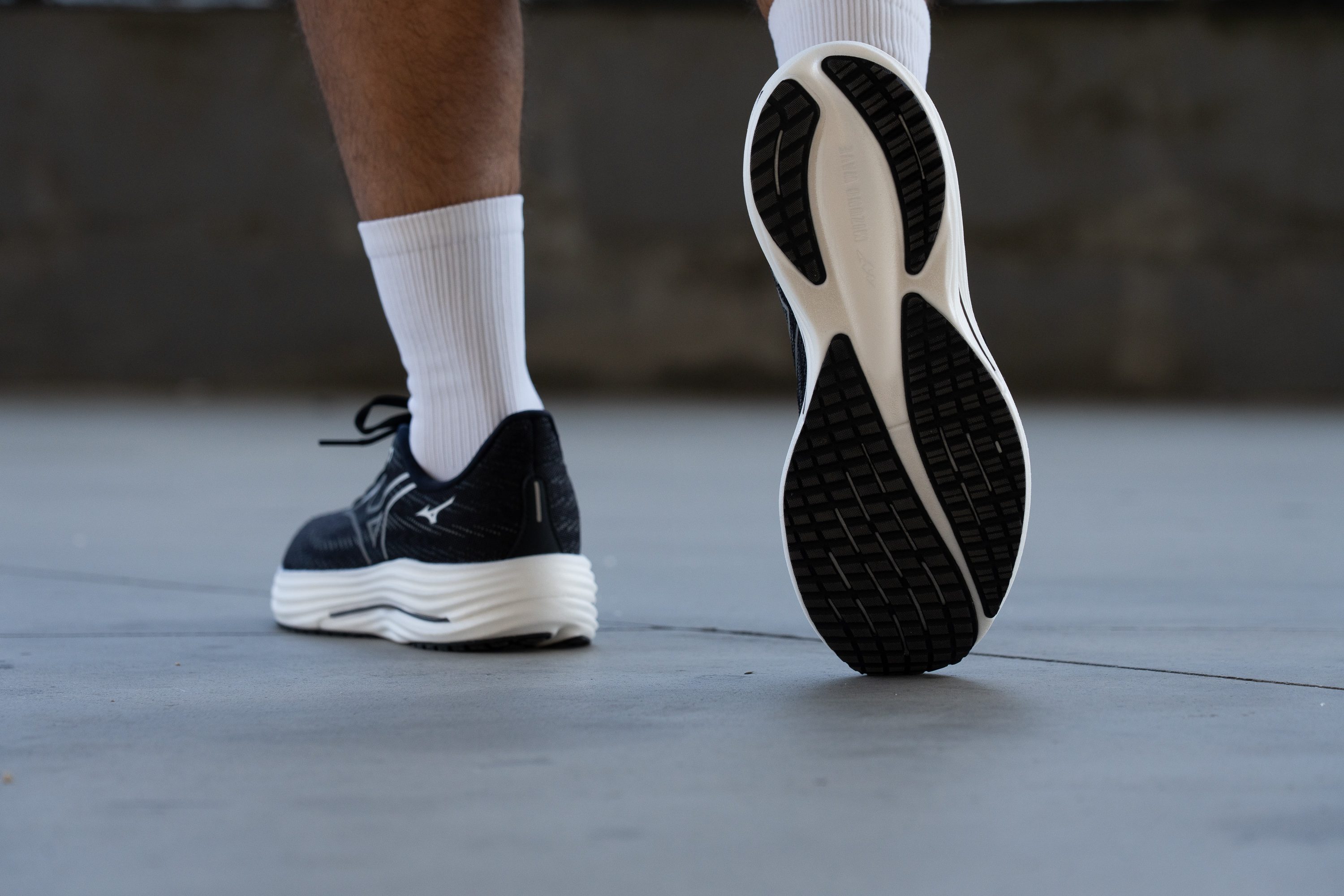
Flexibility / Stiffness
When we tested its flexibility to 30 degrees in our machine, the Wave Rider 29 needed 15.8N of force, which places it in the average range for a versatile daily trainer. However, a bit more flexibility could be interesting in a shoe with a classic rocker profile.
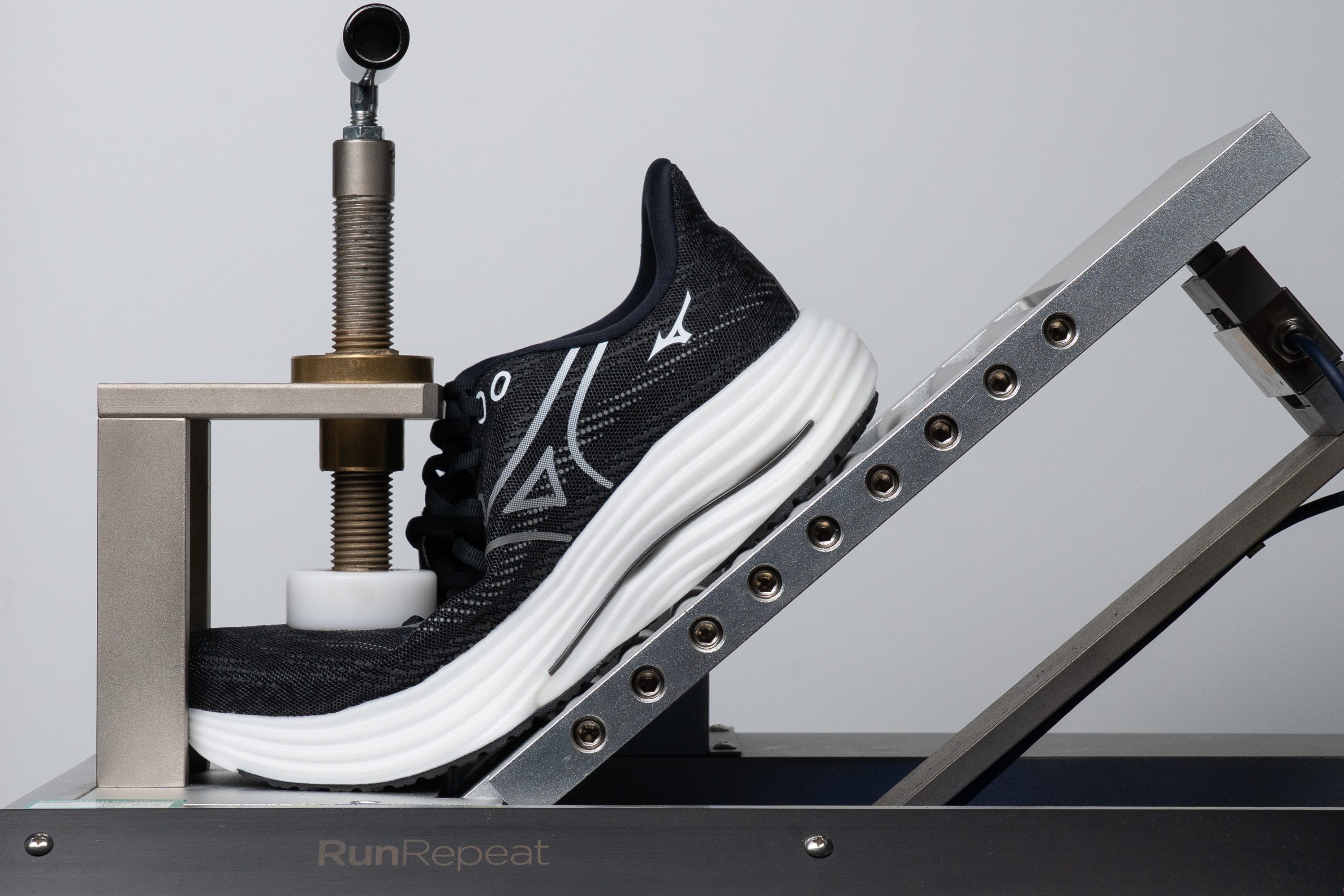
| Wave Rider 29 | 15.8N |
| Average | 15.3N |
Weight
This shoe shows clearly why it matters when brands move from basic EVA foams to supercritical formulations. The Wave Rider 29 has more foam underfoot than its predecessor and much better shock absorption, yet it is still 6% lighter at 9.1 oz or 258g.
As we’ve been saying during the review, we keep finding small improvements, and this is another one.
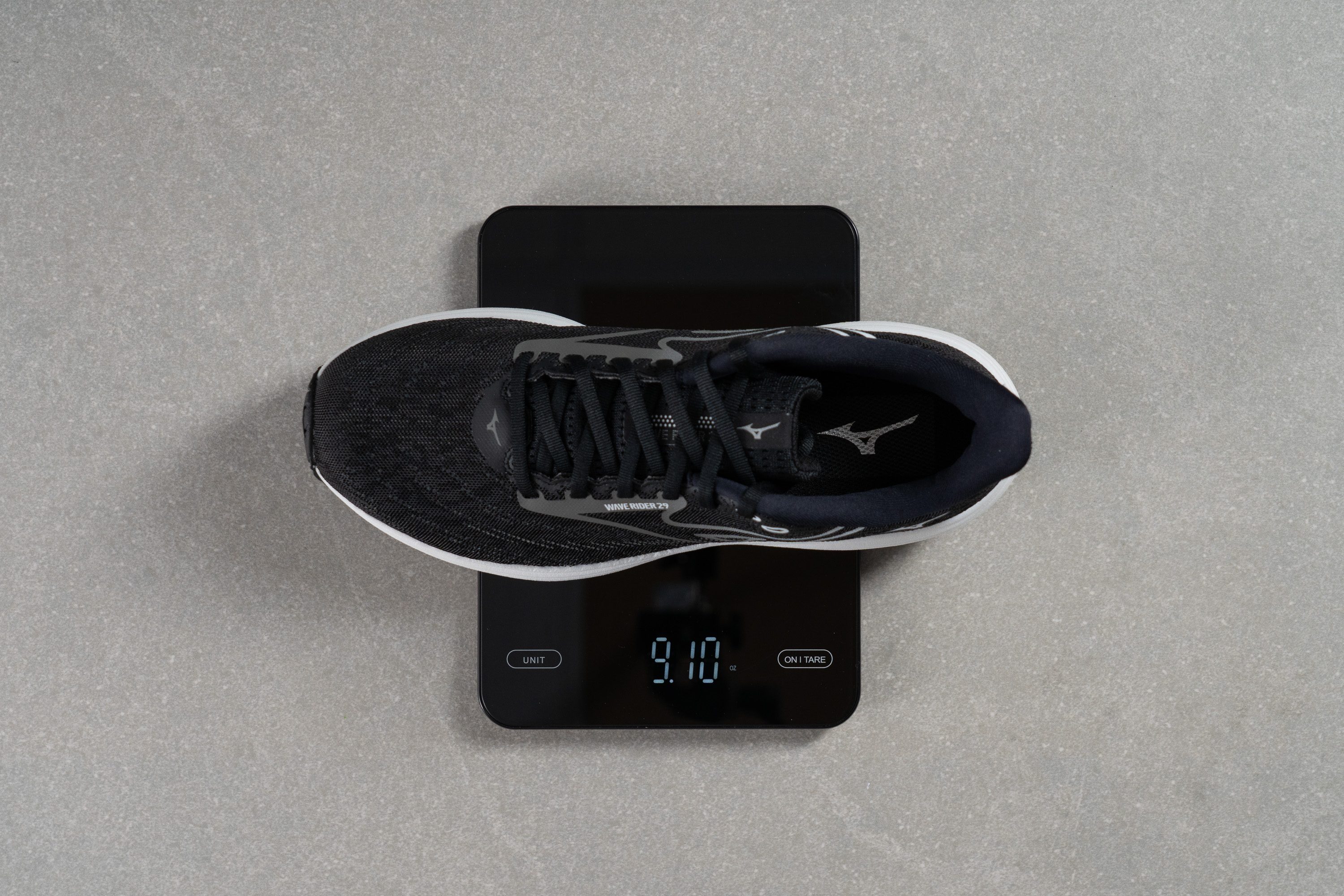
| Wave Rider 29 | 9.1 oz (258g) |
| Average | 9.3 oz (264g) |
Breathability
We discovered that the Mizuno Wave Rider 29 uses a two-layer jacquard mesh upper designed to improve comfort.
It works well, although it reduces breathability a little. We gave it a 3/5, which offers decent ventilation for most days, but it may fall short in very hot and humid climates like Southeast Asia.
Mizuno also focused on stability, and that’s why most of the ventilation is concentrated in the toebox area.

When we observed the mesh under our microscope, we found a simple construction with no extra elements. Mizuno used a reliable fabric they have used before and that keeps costs under control.
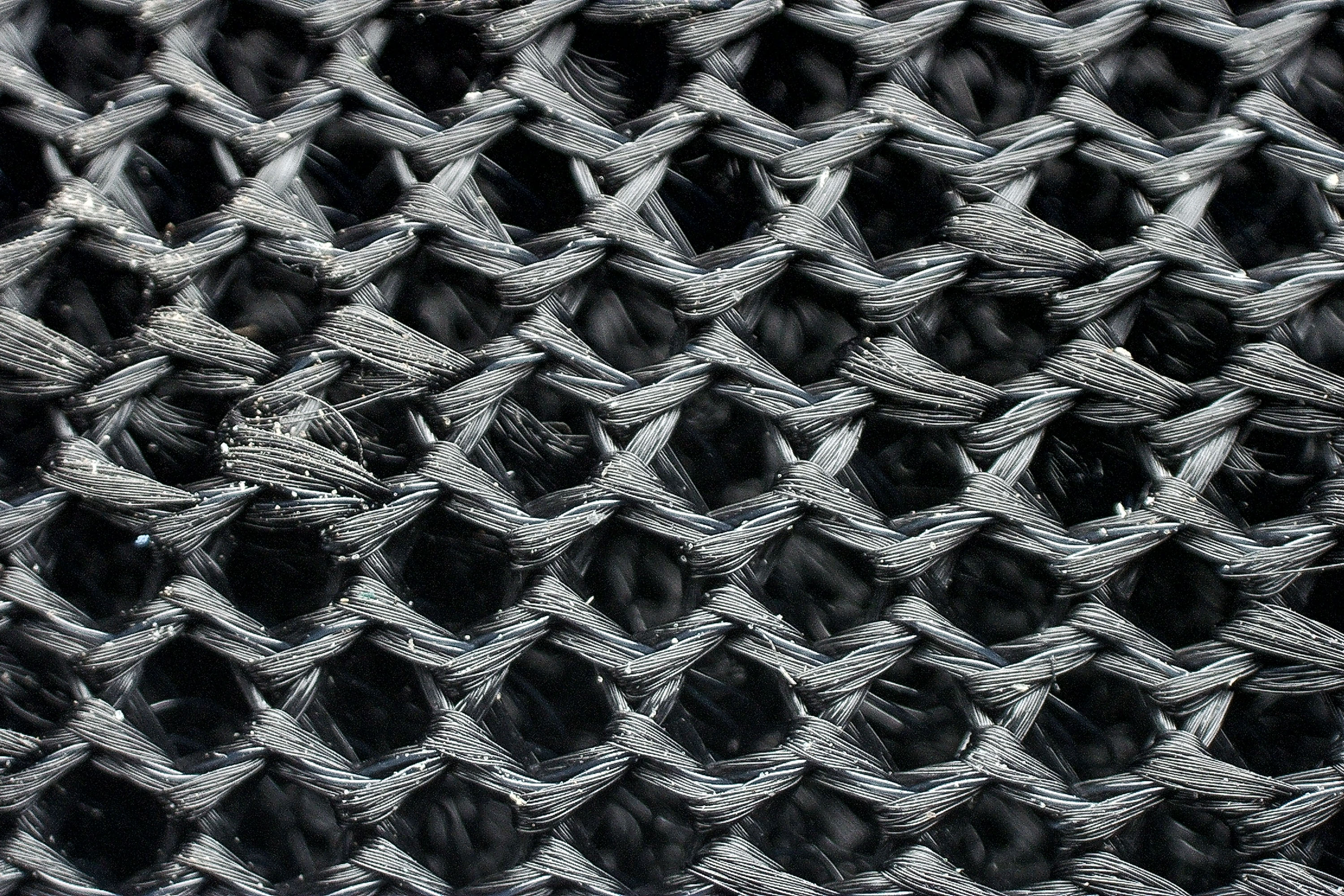
If we have to define the upper in a few words, we’d say it does its job well and never becomes a problem, but it doesn’t stand out either.
| Wave Rider 29 | 3 |
| Average | 3.7 |
Stability
Lateral stability test
One of the main reasons to choose a Wave Rider has always been its impressive stability despite its compact size, and we found that the 29th edition keeps those same qualities. The Wave Plate supports heel and midfoot strikers, giving a more stable ride than many neutral competitors.
Torsional rigidity
Due to the Pebax plate, the Wave Rider 29 is also a bit less flexible than some competitors at 4/5, so keep that in mind if you prefer a shoe that moves with your foot instead of staying flatter for added stability. It’s all about trade-offs.
| Wave Rider 29 | 4 |
| Average | 3.5 |
Heel counter stiffness
The heel counter is also focused on support, sitting on the firmer side and scoring 4/5 again, although there is enough foam around it to maintain proper comfort.
| Wave Rider 29 | 4 |
| Average | 2.9 |
Midsole width - forefoot
The stable feel of the Wave Rider 29 does not come from a wide midsole base, and that becomes clear when measuring the shoe with digital callipers. The forefoot reaches 114.2 mm, which sits right around the average for running shoes.
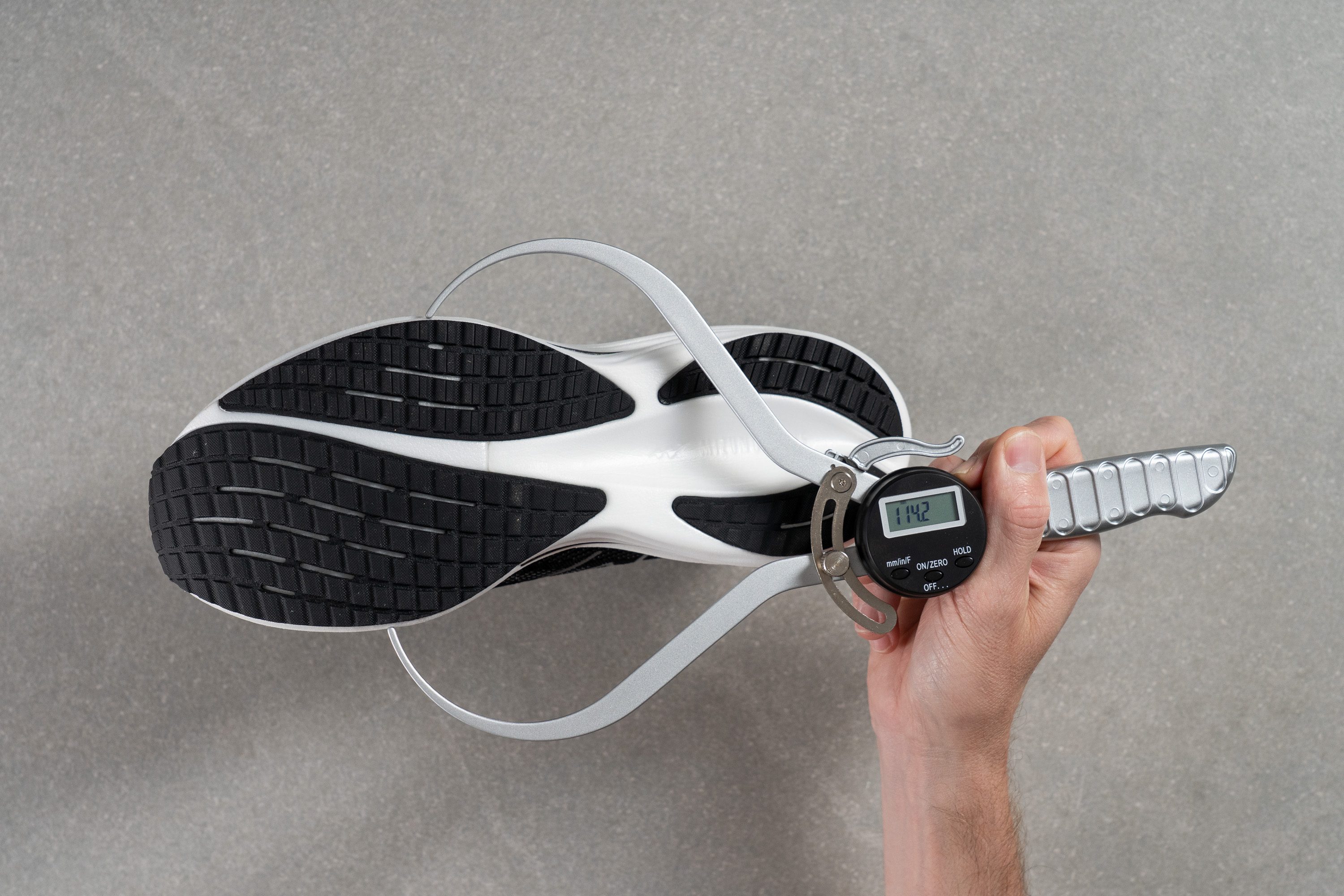
| Wave Rider 29 | 114.2 mm |
| Average | 114.4 mm |
Midsole width - heel
The heel follows the same design language and measures 89.6 mm. In our view, it is clear that Mizuno wanted to keep a versatile and classic feel with this shoe, and we saw that reflected in both the minimal rocker and the compact midsole.
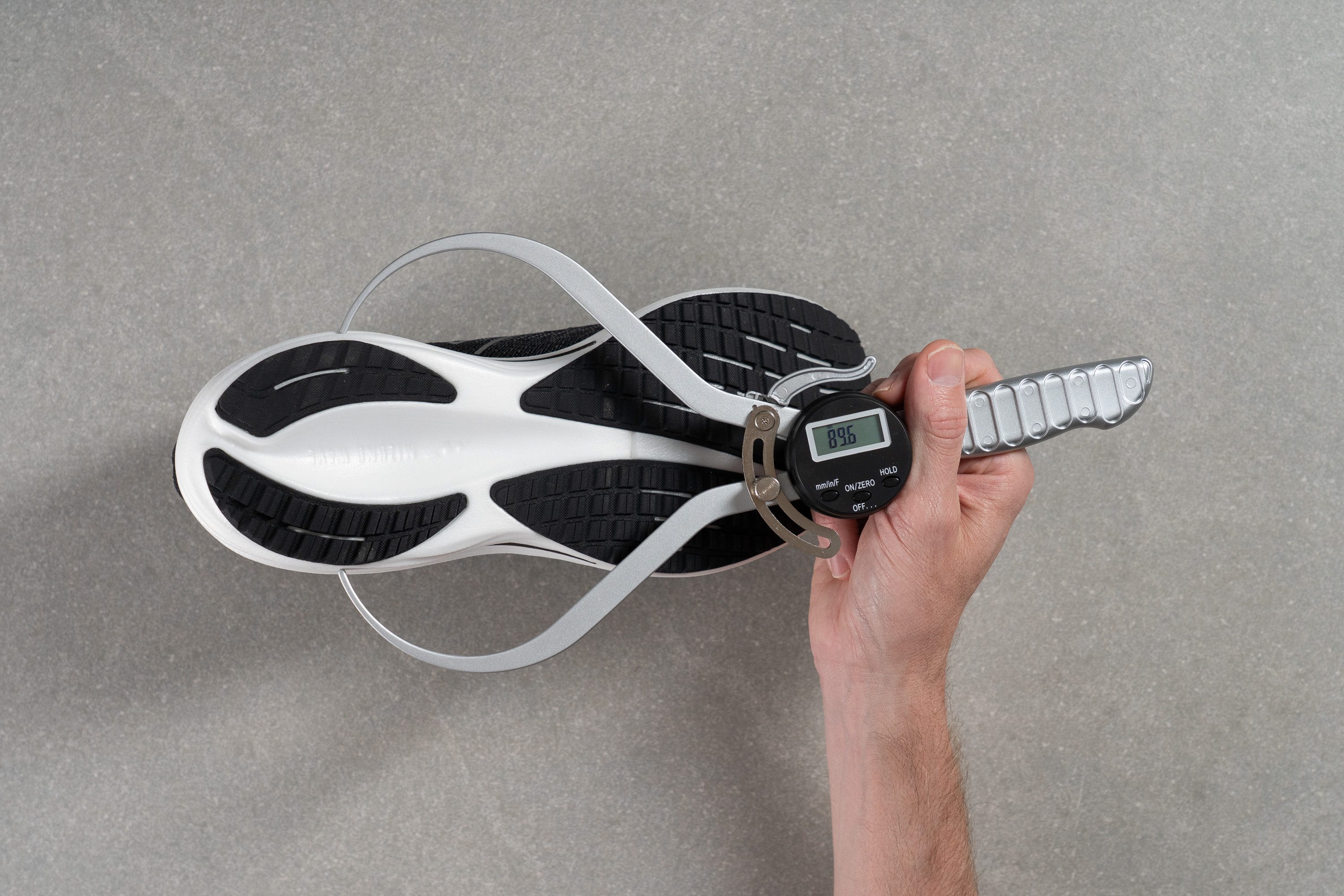
| Wave Rider 29 | 89.6 mm |
| Average | 90.7 mm |
Durability
Toebox durability
A dependable daily trainer must also offer reliable durability, so we were eager to see if the Wave Rider 29 meets our standards.
In our first test, applied to the toebox, we recorded a 3/5 score, which is solid and clears the first challenge.
| Wave Rider 29 | 3 |
| Average | 2.6 |
Heel padding durability
The second test was much better, as the Wave Rider 29 earned a full 5/5 score and made it clear that no runner will need to worry about early wear in this area.
| Wave Rider 29 | 5 |
| Average | 3.4 |
Outsole durability
The X10 rubber behaved more like the toebox than the heel padding, delivering a result that is good enough to avoid early wear but also far from excellent. We found 1.0 mm of damage after lifting the Dremel tool, which is in line with the average result.
| Wave Rider 29 | 1.0 mm |
| Average | 1.1 mm |
Outsole thickness
Mizuno played it safe by adding 3.0 mm of rubber to protect the foam, a considerable amount that provides more confidence in the outsole’s durability.
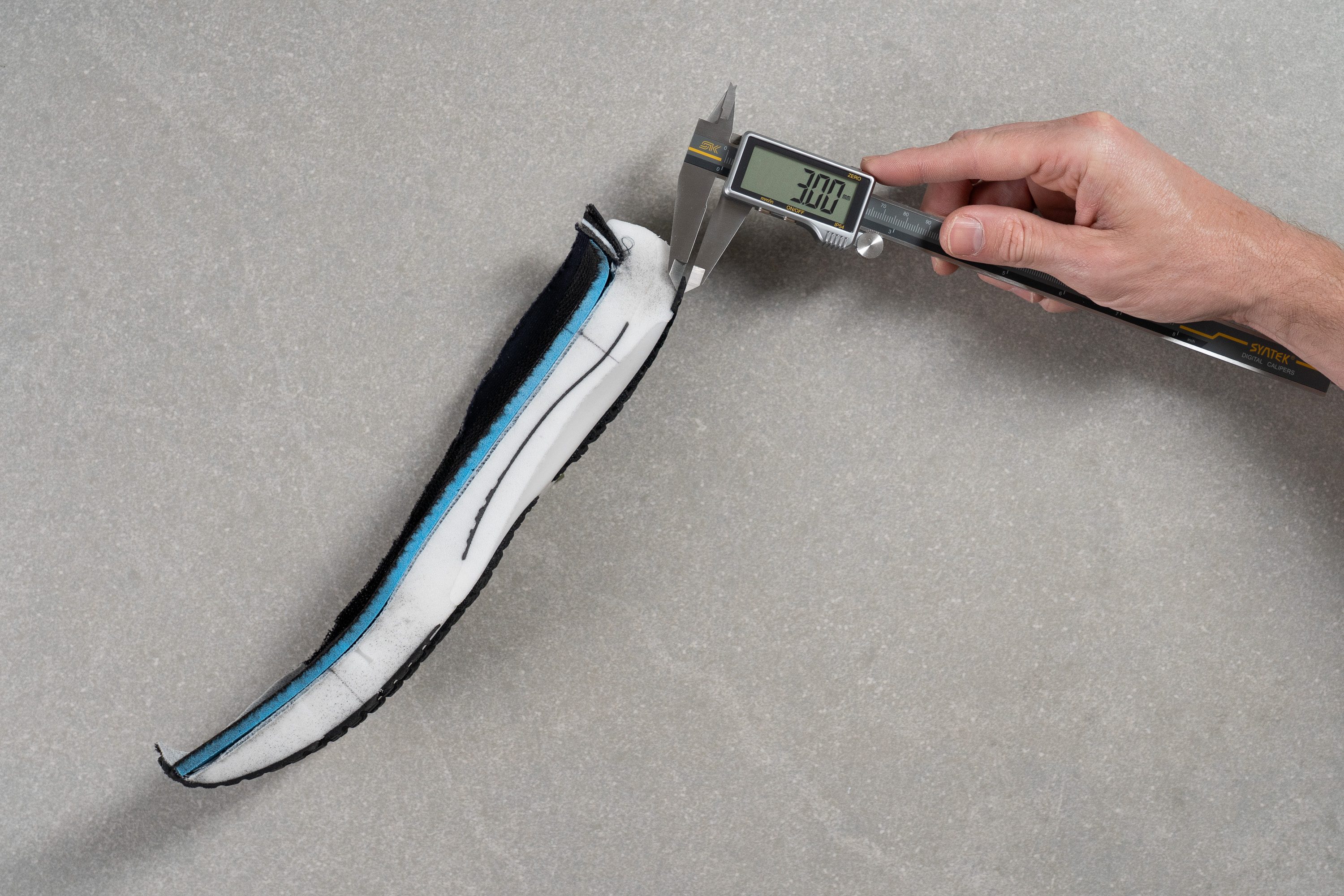
| Wave Rider 29 | 3.0 mm |
| Average | 3.2 mm |
Misc
Insole thickness
The insole is slightly thicker than usual at 5.3 mm.
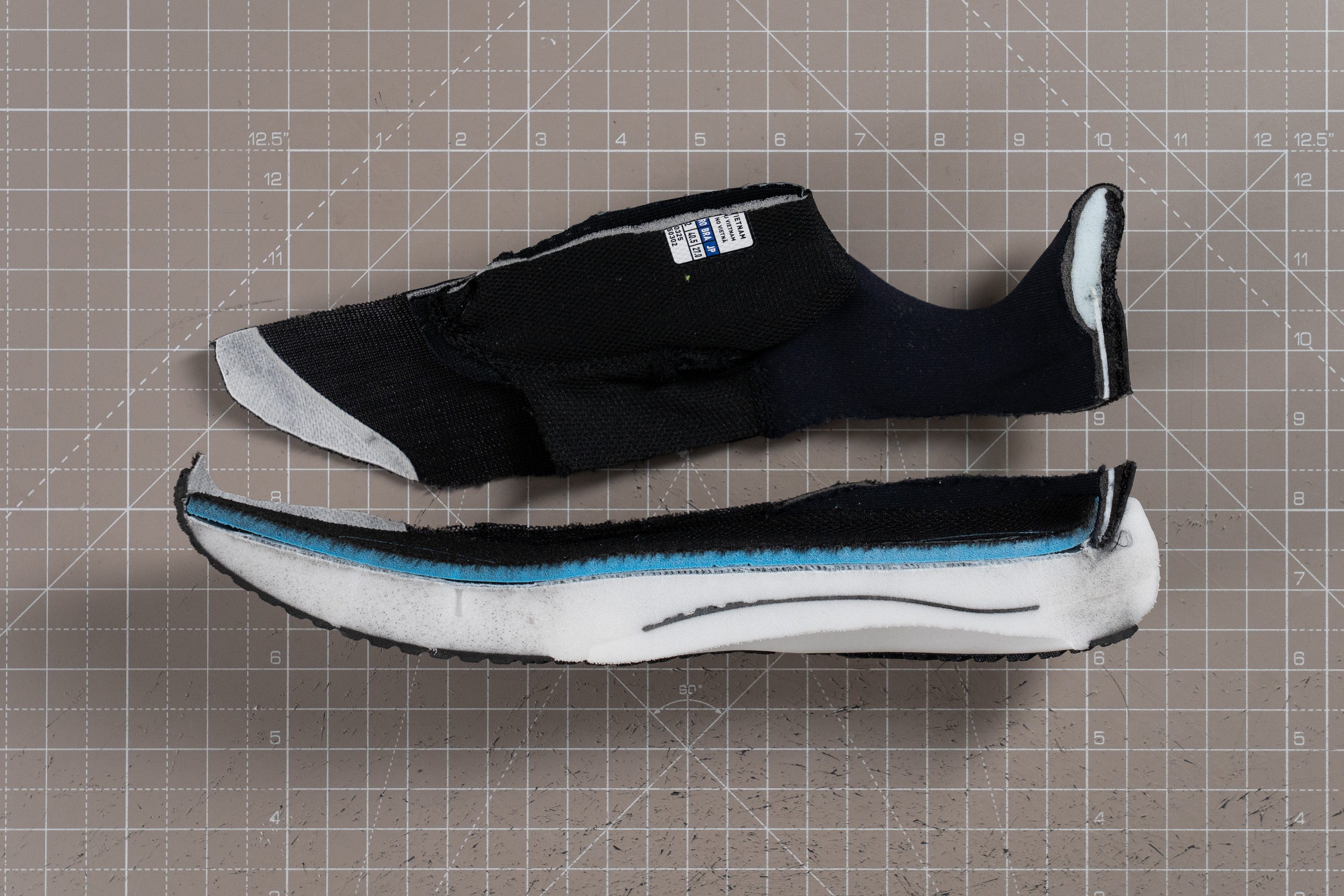
| Wave Rider 29 | 5.3 mm |
| Average | 4.5 mm |
Removable insole
Since the insole is on the thicker side and fully removable, you can insert almost any third-party option into the Wave Rider 29 and it will fit without issues.

| Wave Rider 29 | Yes |
Midsole softness in cold (%)
Enerzy NXT represents a clear evolution for Mizuno over the old Enerzy, as it is lighter and slightly bouncier. However, it is still EVA, so it does not perform better in cold conditions and became quite firm after 20 minutes in our freezer, increasing by 34%.
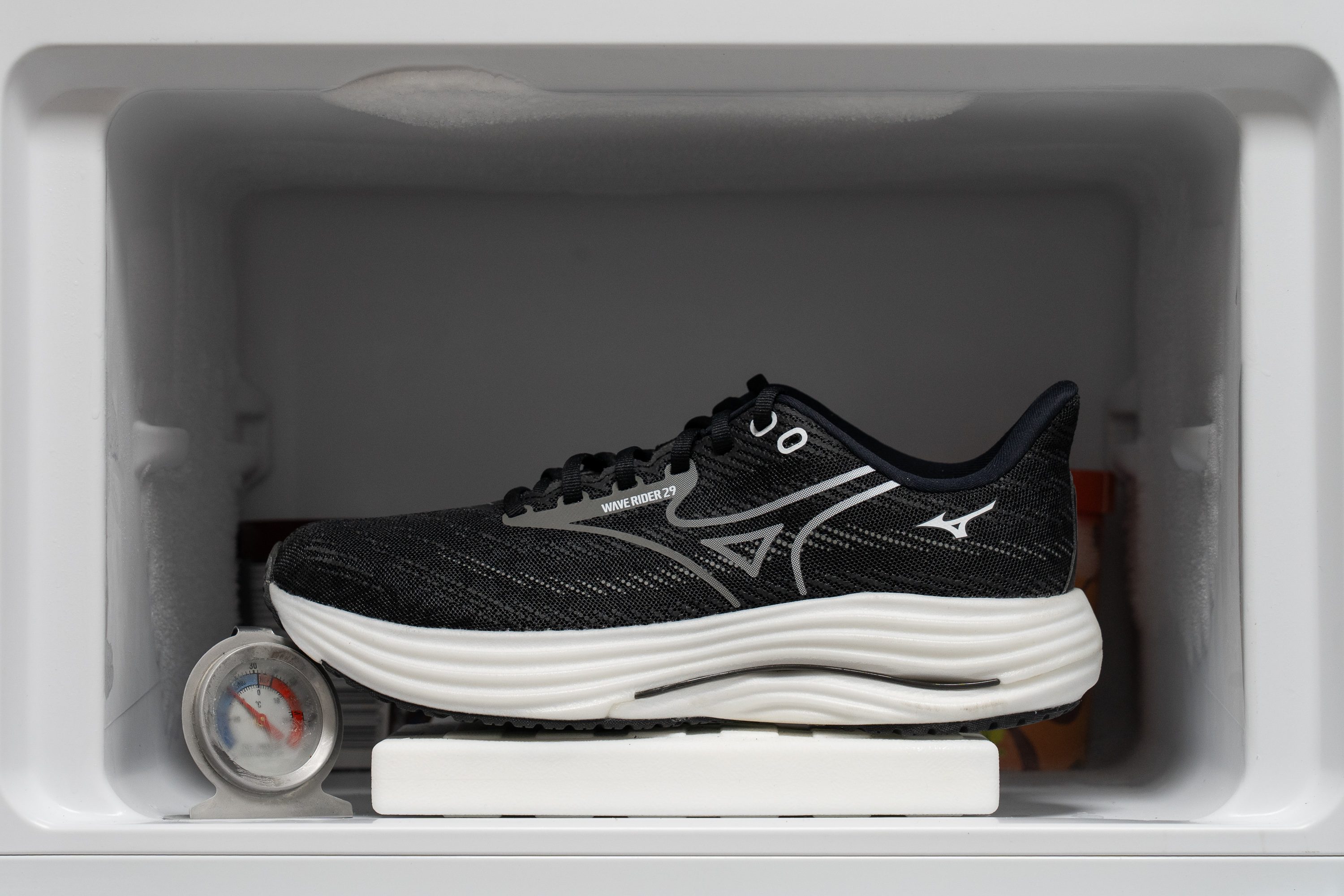
| Wave Rider 29 | 34% |
| Average | 24% |
Reflective elements
We found in the lab that the Wave Rider 29 includes a small reflective strip on the heel. It is better than nothing!
| Wave Rider 29 | Yes |
Tongue padding
The Wave Rider series has always been a no-nonsense shoe, so there are no unusual lacing systems here. We found the usual reinforced punched eyelets that never tear, complemented by flat laces. Not very fancy, but it works perfectly.
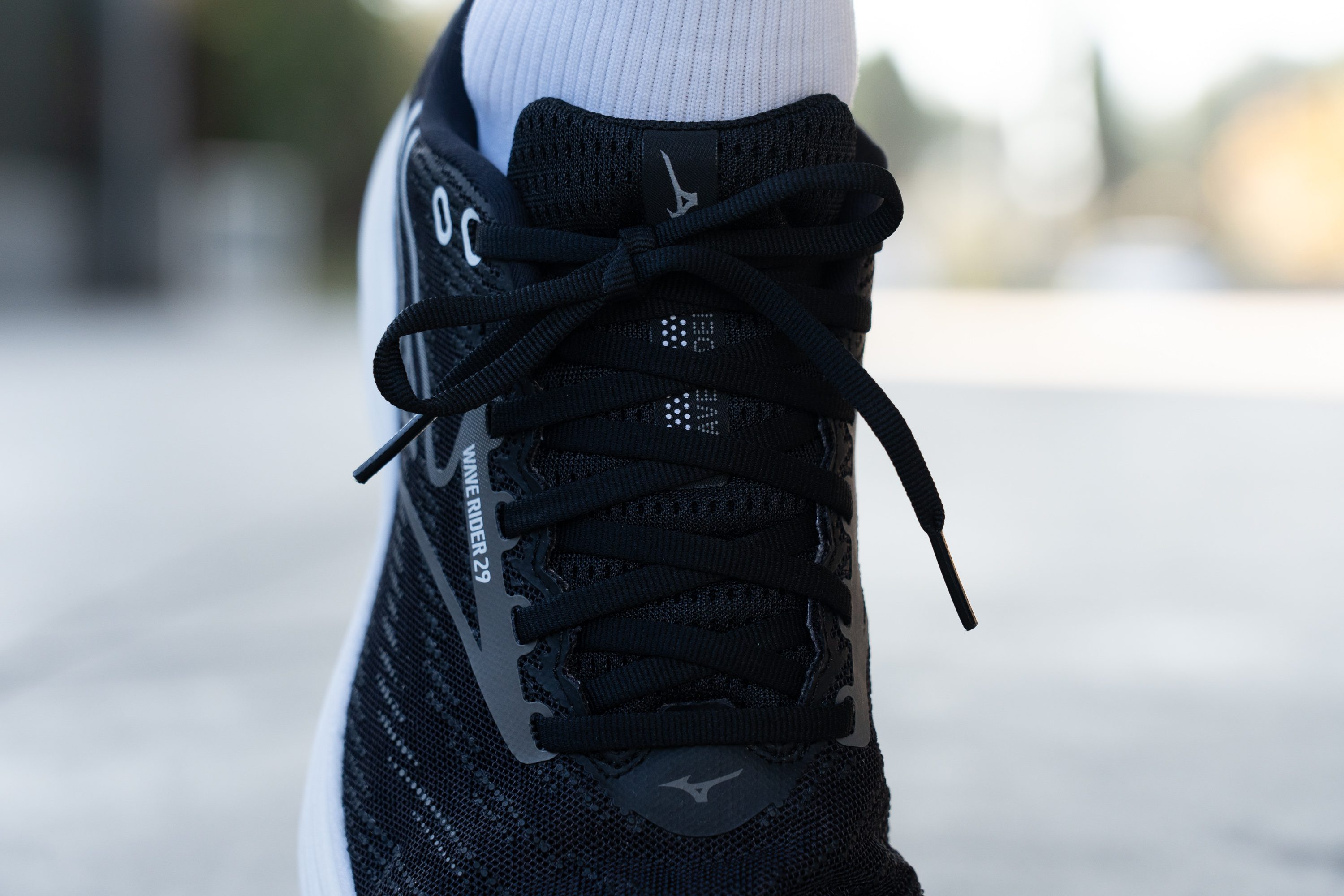
The tongue is also well cushioned at 7.9 mm throughout its whole length, which seems like a good decision for this shoe. Comfort is present, and even if you overtighten the laces, the foam takes the pressure for you and protects your instep.
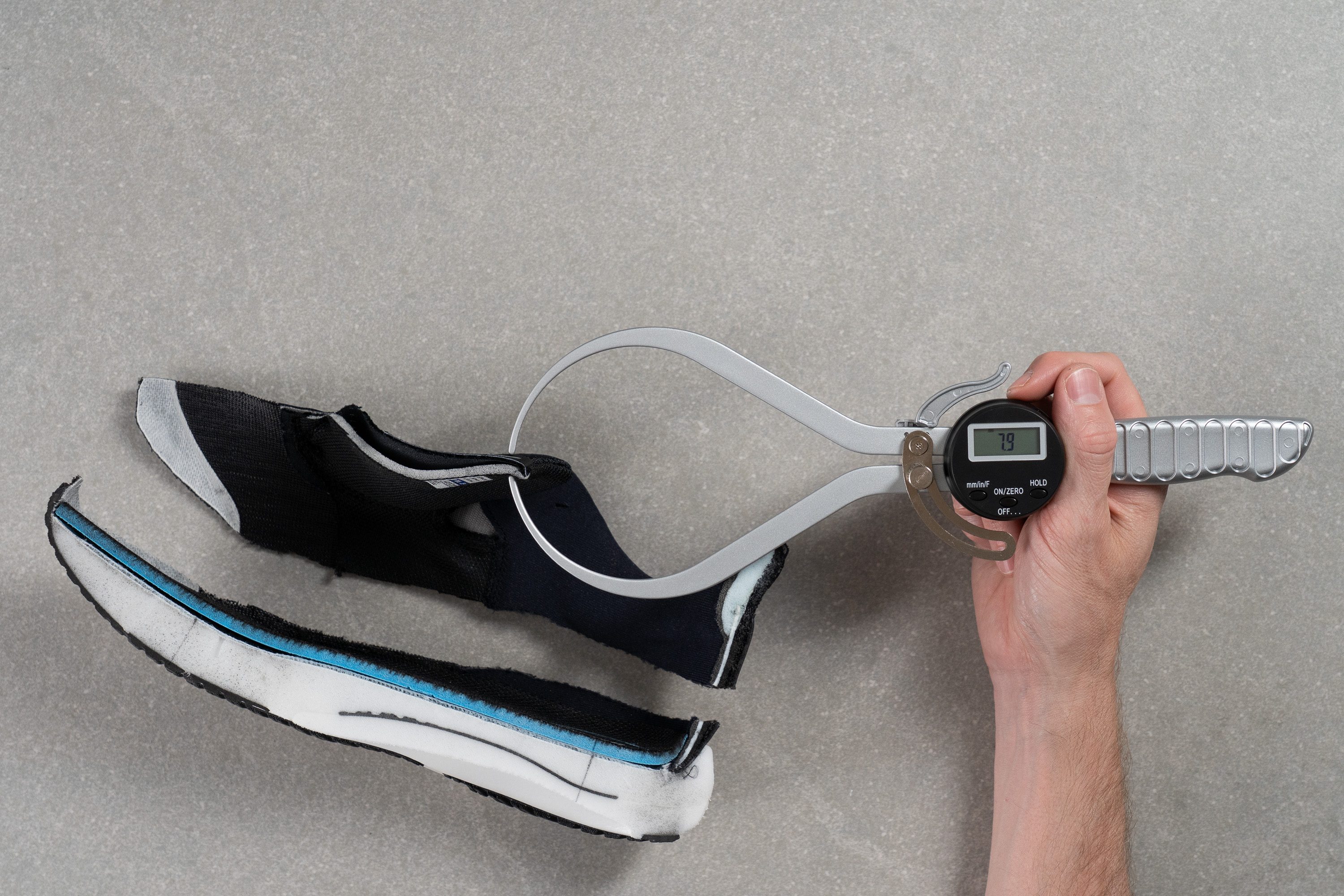
| Wave Rider 29 | 7.9 mm |
| Average | 5.8 mm |
Tongue: gusset type
Some brands cut corners by using a non-gusseted tongue, but Mizuno went with a full-gusseted design that noticeably improves the overall fit.

| Wave Rider 29 | Both sides (full) |
Price
The Wave Rider 29 comes with a small price increase that, in theory, should be justified because the new Enerzy NXT foam is now used throughout the entire midsole. It is a good all-rounder with solid value, but many competitors offer more bounce for less money, so this higher cost may push some runners toward other brands.
| Wave Rider 29 | $150 |
Heel tab
The Wave Rider 29 comes with an extended heel collar design that is very easy to grab.
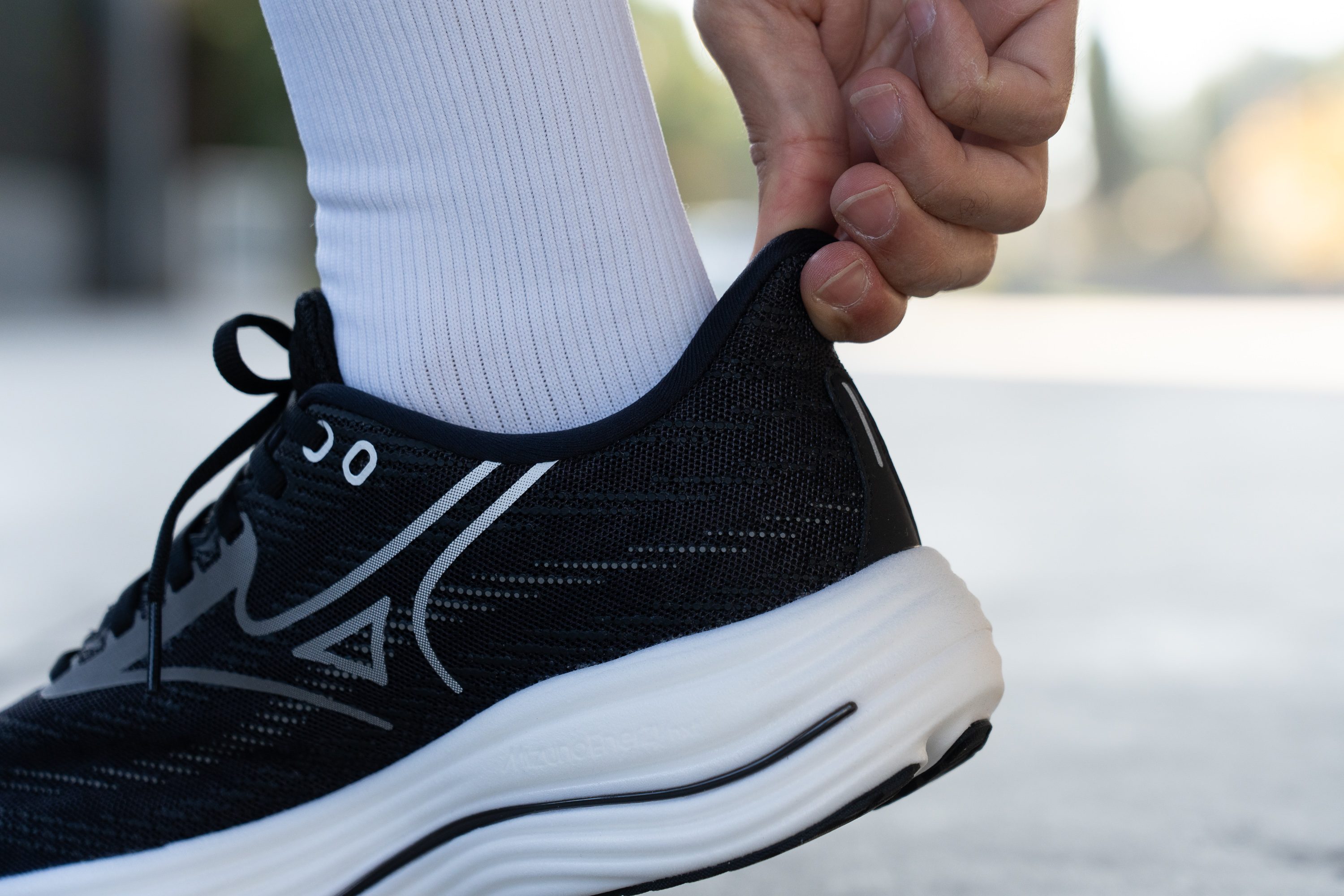
| Wave Rider 29 | Extended heel collar |

